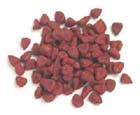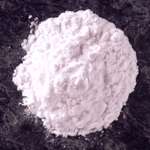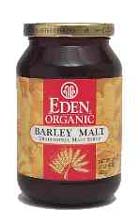|
|
Glossary Selection
Annatto | |||
 | A tropical American evergreen shrub or small tree, called aBixa orellana, having heart-shaped leaves and showy, rose-pink or sometimes white flowers. Also called lipstick tree. The seed of this plant, used as a coloring and sometimes as a flavoring, especially in Latin American cuisine. ),( A yellowish, rust red dyestuff obtained from the seed aril of this plant, used especially to dye fabric and to color food products a bright orange such as margarine, oil and cheese. | ||
Agar-Agar | |||
| Agar-agar is typically sold as packaged strips of washed and dried seaweed, or in powdered form. Raw agar is white and semi-translucent. For making jelly, it is boiled in water at a concentration of about 0.7-1% w/v (e.g. a 7 gram packet of powder into 1 litre of water would be 0.7%) until the solids dissolve, after which sweeteners, flavouring, colouring, and pieces of fruit may be added. The agar-agar may then be poured into molds or incorporated into other desserts, such as a jelly layer on a cake. | |||
Arame | |||
 | In Japanese, it means "the rough maiden". It is a social plant that grows in association with two other seaweeds, hiziki and ecklonia. | ||
Arrowroot | |||
 | A delicate starch used to thicken gravies and desserts, derived from a West Indian water plan. Interchangeable with potato starch and corn starch. Though more expensive, it is considered to be more nutritous by some and give more clear and limpid results according to Julia Child. | ||
Koji | |||
| Japanese word for starter. This is usually the mold named Aspergillis oryzae, used in making miso, amasake, sake, etc. | |||
Hungarian Paprika | |||
| Paprika, Capsicum annuum, is a sweet-to-mildly hot cultivar of the chile pepper of the family Solanaceae. It is cultivated for its fruit, which are dried and used as a spice or seasoning. C.annuum is a native of South America; however it is cultivated most extensively in Hungary. The English word was borrowed directly from Hungarian, which in turn borrowed the term from the adjacent Slavic peoples, among whom the word has survived since its inception in Proto Indo-European (p+p+r). Modern variations of the word exists in most European languages. The word "paprika" can be used to describe both the fruit and the spice. | |||
Hoisin | |||
 | Hoisin sauce, also called Chinese barbecue sauce and suckling pig sauce, is a Chinese dipping sauce for dishes including Peking Duck, spring rolls and barbecued pork. Known in Vietnamese as tuong den (literally black sauce), Hoisin sauce is also a popular condiment for ph?. It is similar to the sweet noodle sauce made from fermented soybeans, but has the added ingredients of garlic, vinegar, and chile peppers. Additionally, it tastes less pungent than sweet noodle sauce. Mandarin-style Hoisin sauce ingredients include water, sugar, soybeans, white distilled vinegar, rice, salt, wheat flour, garlic, and red chili peppers, and several preservatives and coloring agents. Traditionally, Hoisin sauce is actually made using sweet potato, also known as kumara. In the West, Hoisin sauce is often mistakenly referred to as "plum sauce", even though it contains no plum. | ||
Barley Malt | |||
 | Barley malt syrup is a sweetener produced from sprouted barley, containing approximately 65 percent maltose, 30 percent complex carbohydrate, 3% protein. Malt syrup is dark brown, thick and sticky; and possesses a strong distinctive flavor, similar to that of molasses. It is about half as sweet as white sugar. Barley malt syrup is best used in combination with other natural sweeteners. | ||
Beach Plums | |||
 | Beach plums are stone fruits, related to other plums, cherries and peaches. Plants grow 4 to 10 feet tall and produce a profusion of white or pink flowers in mid-May, later than most other stone fruits. The half- to one-inch-diameter fruits ripen in late summer and are generally reddish to deep purple with a waxy bloom. They are quite acid with a crisp, tart, juicy flesh and cherry-like pit, and can be substituted for cherries or plums in recipes. Mostly wild-gathered fruits are used to make jams and jellies, which are often sold in resort areas along the coast. | ||
Filberts | |||
 | Filberts are cultivated hazelnuts. | ||




